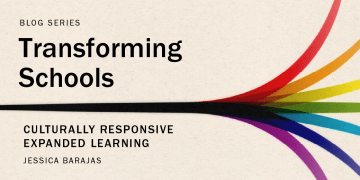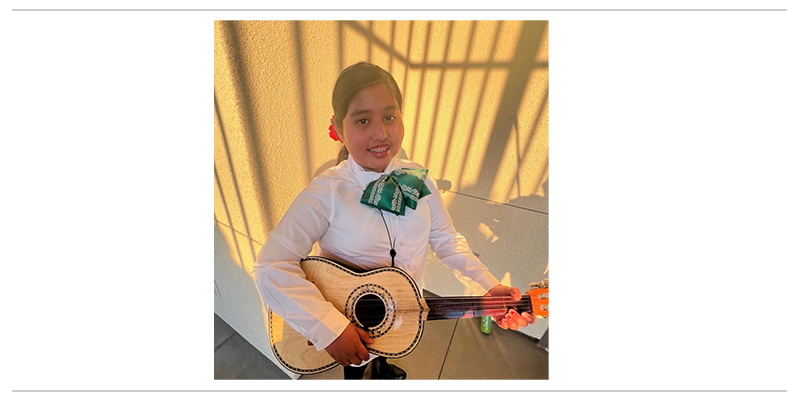Expanded Learning in Action: What Students Have to Say

This blog is part of the Transforming Schools series, which shares effective practices and foundational research for educators, students, families, and policymakers who are reimagining schools as places where students are safe and can thrive academically, socially, and emotionally.
Grace looked into the crowd; her eyes caught the proud gaze of her mom, grandma, and siblings in the audience. As a 6th-grader, she found herself at the University of California, Irvine for her first solo performance. Taking a breath, she waited for the music to cue her and started to sing “Cariño.”

What is Expanded Learning?
Examples of expanded learning opportunities include before- and after-school, weekend, and summer programs. They provide more time, enhanced staffing, and enriched opportunities for student learning and engagement through academic instruction, enrichment and extracurricular activities, and individualized support. California invests in expanded learning programs through the California Expanded Learning Opportunities Program (ELO-P), which allocates $4 billion per year to support before- and after-school, as well as summer, programs for transitional kindergarten (TK) through 6th-grade students across the state. Together, these expanded learning opportunities can provide students with the equivalent of up to 90 days of additional school each year.
A significant body of research has found that well-implemented and well-attended expanded learning programs are associated with improvements in student attendance, behavior, and academic achievement, including for multilingual students. High-quality expanded learning programs also provide students with opportunities to build their youth leadership skills, and a recent longitudinal study finds that participation in these programs benefits students for life: As adults, those who participated in after-school programs were more likely to graduate and pursue higher education, secure better jobs and earn higher incomes, and be engaged in their communities.
Expanded learning is one of the key practices that support the implementation of community schools, an evidence-based strategy that unites schools, families, and community partners to improve student outcomes.
The Anaheim Elementary Succeeds! Mariachi Program and Oakland High School’s East Bay Asian Youth Center Peer-to-Peer Mentorship Program are examples of culturally responsive expanded learning programs that have leveraged state and federal funding to positively impact students.
The Anaheim Elementary Succeeds! Program
Overview
The Anaheim Elementary Succeeds! expanded learning program is a before- and after-school program grounded in four pillars: Student Voice and Leadership, Social Emotional Learning, Academic Support, and STEAM-D (science, technology, engineering, art, math, and dual language immersion education). Anaheim Elementary is blending and braiding funding from ELO-P, After School Education and Safety, and the California Community Schools Partnership Program (CCSPP), for its expanded learning.
Anaheim Elementary School District in Southern California serves a diverse population of approximately 16,000 students across 24 schools. More than 80% of students are from low-income backgrounds, and 46% are English learners. Anaheim’s expanded learning program centers equity and is rooted in listening to and partnering with families. District Assistant Superintendent Yadira Moreno described the four pillars as reflecting parent feedback. Parents requested more academic tutoring and enrichment classes for their students—classes they would not otherwise be able to afford.
Mariachi music, traditionally from Mexico, mirrors the heritage of much of Anaheim Elementary’s student population and is one of the offerings under the STEAM-D pillar. While the program is offered as an after-school elective, teachers are also supported in integrating mariachi music during the school day.
Impact
The Anaheim Elementary Succeeds! program has grown from serving 5,000 students in 2021 to serving 10,000 in 2023. As of 2024, 75% of all TK–6 students in the district attend ELO-P programs. Family and student testimonials presented at a 2024 school board meeting reflected that Anaheim’s expanded learning program has consistently increased students’ confidence in school. As Grace explained, “It brings us confidence in who we are, our culture, to embrace that I’m Mexican and that I’m also Mexican American.”
The mariachi program also helped Grace develop her communication and interpersonal skills. While initially shy about singing in public, with practice, Grace built confidence in her singing that carried over into public speaking in her classes. Grace added, “Mariachi has helped me with communication and listening skills; I’ve also really connected with my classmates.”
Grace’s experience in Anaheim’s culturally responsive expanded learning program has also inspired her next steps in school and life. In 2025–26, she is attending the Orange County School of the Arts in Santa Ana, and she dreams of playing mariachi music professionally in her future. As Grace’s mom, Maria, was sharing this news, she explained, “Grace had to audition to get a lottery ticket for the school of the arts. We are forever grateful for the skills Gracie learned in the expanded learning programs.”
East Bay Asian Youth Center’s Peer-to-Peer Mentorship Program at Oakland High School
Overview
Another noteworthy culturally responsive expanded learning program is the East Bay Asian Youth Center (EBAYC) Peer-to-Peer Mentorship Program at Oakland High School. Like the Anaheim Elementary Succeeds! program, the mentorship program is made possible through a partnership rooted in the community. EBAYC has been a part of the Oakland community for more than 40 years. Not only has EBAYC been a key partner in Oakland High School’s journey to becoming a CCSPP-funded community school, but EBAYC is also the main provider of expanded learning opportunities for youth at Oakland High.
In 2021, Oakland High’s Culture and Climate Team, made up of school staff, administrators, teachers, and community partners, and convened by EBAYC, conducted a student wellness survey with more than 600 students. According to Rany Ath, the program’s managing director and an Oakland High School alumna, the peer-to-peer mentorship program was a direct response to student data indicating that 9th- and 10th-grade students felt disconnected and needed additional support. Access to peer-to-peer support was one of their top requests.
Through the program, students can access a peer mentor through self-selection, participation in the incoming 9th-grade summer bridge program, or referrals from staff and administrators. Mentors meet with their mentees once a week during their open period or after school.
A Leadership and Employment Opportunity for Mentors
The program, which once hired college students as mentors, now grows its own mentors, paying Oakland High School students $20 an hour to mentor their peers. This also addresses a known desire for employment opportunities among the students. Although ELO-P funding can be used for high schools, the core funding for secondary school expanded learning programs comes from the federal government through the 21st Century High School After School Safety and Enrichment for Teens (ASSETs) program, one of several federal programs whose funding was withheld in July by the U.S. Department of Education and whose future funding is uncertain. Oakland High School braids federal ASSETs funds with city funds, among other sources.
The peer mentorship program prepares approximately thirty 11th- and 12th-grade mentors each year, and with a typical caseload of three mentees per mentor, over 90 mentees are supported annually. Peer mentors reflect the diversity of Oakland High School, which serves 1,525 students; the student body is 21% African American, 28% Asian, and 40% Hispanic. Mentors are provided with professional development that includes role-playing real-life scenarios they may encounter with their mentees, as well as access to mental health support for their own well-being.
Impact
The peer mentorship program has made a positive impact on the mentees and the mentors, as well as the school’s overall climate. Findings from a 2024–25 mentee survey conducted by EBAYC showed that 86% of mentees agreed that being in the program improved their mental health, 83% of mentees agreed that the program helped them increase connection to peers, and 80% agreed that it increased their connection to school.
As for the peer mentors, a 2024–25 mentor survey showed that 95% of mentors agreed the program helped them feel more connected to school, and 100% agreed it increased their connection to peers. Additionally, while Oakland High School had an overall graduation rate of 86% in 2024, every senior peer mentor graduated from high school.
Aaron-Anthony Boulware, a former 12th-grade peer mentor at Oakland High School, shared how the program provided mentees with resources for navigating high school and a space to open up about personal challenges. He added that it helped one of his classmates “get out of a really dark place.”
Maria “Fernanda” Garay Archaga is an Oakland High graduate who experienced the program as both a mentee and a mentor. As an immigrant from El Salvador, Fernanda benefited from having a Spanish-speaking mentor who helped her navigate school in 11th grade, while also connecting to her culture and language. Her initial shyness gave way to confidence, and by 12th grade, the experience inspired her to become a peer mentor for other newcomer students.
The leadership experience Aaron and Fernanda gained from being mentors helped inform their career aspirations. For Aaron, among many skills, peer mentorship taught him the importance of being a good listener. He envisions attending business school and then pursuing culinary school to become a chef. He says, “[Peer mentorship] taught me how to take a step back when needed. A lot of people like to lead head forward, and they don’t like other people to talk. I like to lead by letting other people lead sometimes. I think that’s a really important skill, and it’s really necessary in leadership.”
For Fernanda, being a peer mentor inspired her to become a therapist and gave her confidence that the skills she was teaching her mentees could also help others. She explains, “I feel I can practice how to help make people feel better with themselves, and how important it is for them not to give up, and to keep doing their best. It makes me feel more interested in being a therapist when I see my mentees putting into practice the solutions that I have given to them. I hope to become a therapist to help others.”
This fall, Aaron started his first year of college at California State University, Long Beach, and Fernanda is at California State University, Los Angeles.
To learn more about these two programs and the structures that support their implementation, see the session recordings available in English, Spanish, and Arabic, also found on the Shared Learning series website.
